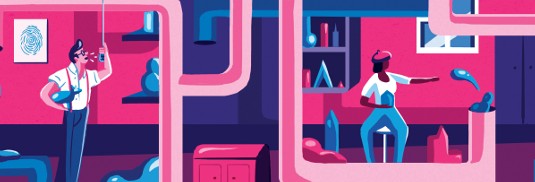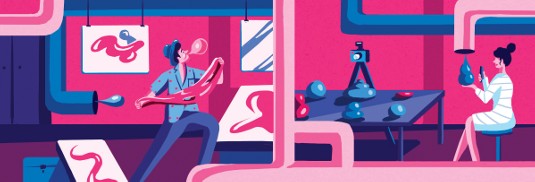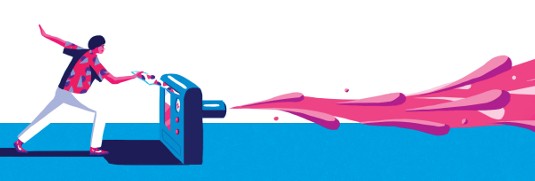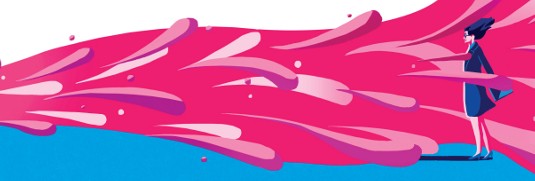How to promote yourself as a designer
How to play to the strengths of your personality and promote your design skills more effectively.
Most creatives spend large chunks of time thinking about other people and their opinions, needs and wishes. From clients and customers to the people you follow on Twitter, there's a vast and varied audience to think about, consider and research. Which might not leave much room to pay attention to yourself. Are you making enough of your personal quirks? How can you promote yourself in a way that suits your personality?
It's often said that great design should be invisible, but that needn't apply to designers as well. There's so much more to your personal brand than your design portfolio and client list. Your personal traits, foibles, interests and obsessions will have had a big hand in forming your creative style and approach, so why not use them to your advantage?
Take illustrator Gemma Correll, who has made great use of her love of pugs – from books and prints to an Instagram feed crammed with photos and illustrations. And it doesn't get much more personal than Mr Bingo's Hate Mail service. He famously invited people to pay for their own personalised insults, and they did – in their droves – leading to a successful book on the subject, as well as an exhibition.
Being authentic
Done the right way, an injection of personality can be a hugely successful move for defining who you are as a creative. It all comes down to honesty, says freelance artist and designer Jon Contino, whose chief passion is hand-lettering. "I'd venture to say that many designers in their 30s and 40s aren't being honest with themselves yet," he says. It was the recession that gave him the push he needed. "I lost all my major paying retainers," recalls Contino. "I kept trying to figure out where I belonged and what kind of work I should be doing.
"Finally I was flat broke, barely making the rent and I said: you know what, now's the time to do it, I'm just going to do the stuff I like," he continues. "What would I be doing if it wasn't my job? That's the most authentic way to do it. People appreciate it if they're getting a true message, which is basically our job to begin with."
Which means discovering your own truth, rather than trying to fake it or copy someone else – all the usual rules of branding still apply. There's a difference between having a genuine preoccupation with foxes or trapeze artists or orange Sharpies and simply pretending to be obsessed because you think it makes you seem interesting. Sooner or later, someone will smell a rat. And there's little joy in being valued for something that you're faking.
It's also a bad idea to try to fake different personality traits, however tempting this may be. Some people are naturally more extroverted, funny, loud, thoughtful, quiet, shy, quirky or sarcastic than others. If you're a wallflower who dreams of being the life and soul of the party, it's highly tempting to just pretend. But that will get exhausting quickly, and that's presuming you can even keep it up.
Get the Creative Bloq Newsletter
Daily design news, reviews, how-tos and more, as picked by the editors.

Brand honestly
Branding yourself requires an utterly honest approach, explains Contino. "If you brand yourself in a certain way and it doesn't work, you'll feel you've misinterpreted who you are, and it will take you into an existential crisis. If you're honest with yourself and you have fun with it, people definitely pick up on that."
"When I was a kid, my dad told me: be who you are, be happy with who you are, and don't try to be something you're not. That's a basic childhood lesson you can apply to yourself as an adult," he says. "As you get older, ideas about individuality can go out of the window. But the more happy you are with yourself, the more interesting and satisfying your life can become."
Focus on your strengths. If possible, ask other people to help point them out. What do they think are your best qualities and the most interesting things about you? If you're shy and quiet, for example, try asking an extrovert to describe your personality. Chances are other people see you as thoughtful and a good listener.
Project yourself
Self-initiated projects are a great way to show personality, says freelance graphic designer Sean Rees, whose own personal projects have included a bespoke typeface and poster series inspired by wire numbers on the office dartboard at creative consultancy Purpose. "It gave me real freedom of self-expression and an opportunity to explore something I may not otherwise get a chance to do," says Rees.
Last year, he addressed an audience of 500 people at the inaugural Point design conference, held in London, on the topic of authenticity – along with Nathan Webb, designer at Purpose. They spoke about the inspiration behind their branding work for the MacGuire Programme: Beyond Stutter, a speech therapy programme Rees has experienced first-hand. "I attend the course to work on my own speech, as well as coaching others," explains Rees.
"The project got picked up by blogs and the design press – the snowball got rolling," he says. "I was genuinely passionate about the subject and had relative freedom to take it in the direction I wanted. That's not always the case with client work, and self-initiated projects can be a useful source for scratching that itch that your day-to-day projects aren't able to reach."
If you've been working on a number of personal projects, you might consider turning them into a selfpromo campaign. Whatever you do though, don't fall into the trap of focusing entirely on your audience and losing yourself in the process. A mailer that's true to your personality will always have something genuine to say about you – if it just looks nice, people may have trouble connecting it to you at all.

Artist and designer Kelli Anderson uses New Year cards as an opportunity to show some personality and have fun. "I get to indulge in an experimental format, freed from client constraints," says Anderson, who is well known for finding new ways to use (or misuse) existing objects, including making innovative creations out of paper. "This is mostly about me getting to experiment, but also to say hi to people I haven't seen in a while," she explains. "I'm sure it serves a promotional purpose even if it isn't promotional-feeling."
Anderson writes about her big projects at length on her website. "I do this mainly to fully own and present the idea on my own terms," she says. She uses the tagline 'Tools and process (and their misuse)' on her website and blog, both of which succinctly and whimsically sum up her approach to creating and give you a glimpse of the person behind the website.
Jon Contino has also developed a heading to sum up his personality – he describes himself as 'Jon Contino, Alphastructaesthetiologist'. "I was actually trying to come up with something really obnoxious, long and ridiculous to put on my website, and it has turned into something with meaning and taken on a life of its own," he says. "I think the reason it works so well for me is that the majority of what I do is branding. There's nothing harder than taking the history of a company and breaking it down to one icon."
Quirky quips
These sorts of descriptive flourishes can be a great way to express some personality, so pay attention to things like blog headings and Twitter biographies. And if you'd rather focus on face-to-face contact, apply the same approach to exhibitions, talks or workshops. Little things can make all the difference, from the name of your talk and the way you write your biography to the outfit you wear. It all adds up, and first impressions can be hard to undo.
Potential clients may form their first impressions from social media, so make sure you show the sides of your personality that you want them to see. Sweary rants and passive aggressiveness probably aren't the way to go, unless they're an established part of your creative persona – Mr Bingo can get away with having a colourfully-worded website, but you might find you just look rude.
It's the more insidious stuff that might really trip you up, though. Like humble-bragging, which Sean Rees warns against doing. "It's lovely to get praise, but resist that temptation to retweet every mention of your work," he says. "And, when collaborating on projects, it's very important to clearly credit people – it's all about honesty. You don't want to give the wrong impression or mislead anybody. Everything you do is essentially a means of self-promotion, consciously or not. We are each crafting our own personal brand."
In the case of Instagram, Rees uses the site as a visual diary. "For me, it's become a record of things I've done, places I've been, things that have captured my attention in my day-to-day life," he says. "As visual people, we notice things around us that others might miss or not notice." Instagram is something to curate, as the pictures you post will have much to say about your approach to your life and work.
Illustrator Eleni Kalorkoti says she focuses on posting images of her work, mostly while in progress, on her Instagram account, while using Twitter as a place to chat and share relevant links, and Tumblr as a scrapbook for her varied interests and range of influences. "Sharing my work and enjoying other people's is my main reason for being on any social media, so I naturally focus on that," she says. "Also, I don't have a cute pet and I have never left any food on a plate long enough to take a photo of it.

"Really though, most of my days are spent working, so if there's anything of interest for me to photograph it's probably something I've made." Just don't force it, is Kalorkoti's advice. "Not everyone who makes pictures enjoys opening up the rest of their lives to the internet. I know nothing whatsoever about Henry McCausland, but it doesn't make his work any less beautiful."
Once again, authenticity is key, which is why Jon Contino warns against becoming Insta-fake. "You see people doing fake nonsense where they draw something and then lay out a page and there's a pencil, a cup of coffee and a lamp arranged just so – it's obviously staged," he says. "I tend to show a mix of projects, work in progress, behind the scenes images and a little personal stuff like a baseball game with my family or some old drawings from high school, but everything tends to work as a piece of a bigger story."
"Everyone knows I do hand-drawing stuff, and I try to make it as real as possible," he adds. "If there's a mistake in there, I leave the mistake. It's nice to be able to do something that feels real." It also lets people know that he values authenticity, while someone else might be more concerned with perfectionism or the perfect camera angle.
Twilight snaps
Contino is a night owl, a quirk he uses to his advantage on Instagram. "My best work comes out at 2 or 3am, so I'll take a picture and post it. Those are the ones that seem to get the most attention. You get the people who are just getting home in California or just waking up in Europe, so I've found that's the time that works best for me."
Print-maker and freelance designer Anthony Burrill also takes a very thoughtful approach to Instagram. He travels quite a lot, so his posts are a mix of work images and photos taken on his journeys. "Everything you put out there online, whether it's on your website, Instagram or Twitter, it all helps," he says. "Of course you have to stick at it for a long time – it won't happen overnight. In the short term, it's important to do good work and work with interesting clients. Be truthful about who you are and why you're doing it."
Known unknowns
The problem with this cumulative effect however is that it's notoriously hard to trace. You may not quite know what it is that's working for you. "No one ever directly mentions anything like Instagram until after we're already working together," says Burrill. "Then I might get art directors saying: 'Oh yeah, I love your Instagram feed and I've been looking at it the whole time.'"

"The good thing about the design industry is that it's self-feeding," observes Sean Rees. "If someone creates an interesting piece of work and manages to get it featured on a popular design blog, it creates a ripple effect where it gets picked up by other blogs, talked about on Twitter and then written about in the design press. Images get linked to inspiration sites. All of these things combined creates one massive social media snowball which reaches a much broader audience than its original intention."
You can't control where that snowball goes, of course. All you can do is think carefully about what you put into it. "I always try to be as honest and truthful as possible," says Anthony Burrill. "The more you do that, the more you realise it's the best way to do it."
Words: Anne Wollenberg Illustrations: Jack Hudson
This article originally appeared in Computer Arts issue 231.

Thank you for reading 5 articles this month* Join now for unlimited access
Enjoy your first month for just £1 / $1 / €1
*Read 5 free articles per month without a subscription

Join now for unlimited access
Try first month for just £1 / $1 / €1

The Creative Bloq team is made up of a group of art and design enthusiasts, and has changed and evolved since Creative Bloq began back in 2012. The current website team consists of eight full-time members of staff: Editor Georgia Coggan, Deputy Editor Rosie Hilder, Ecommerce Editor Beren Neale, Senior News Editor Daniel Piper, Editor, Digital Art and 3D Ian Dean, Tech Reviews Editor Erlingur Einarsson, Ecommerce Writer Beth Nicholls and Staff Writer Natalie Fear, as well as a roster of freelancers from around the world. The ImagineFX magazine team also pitch in, ensuring that content from leading digital art publication ImagineFX is represented on Creative Bloq.
